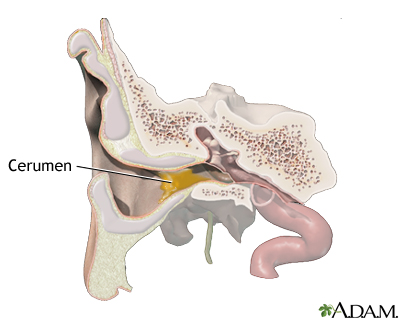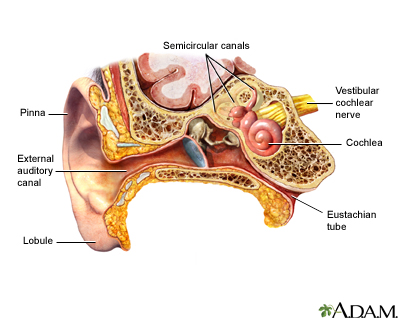Definition of Wax blockage
Wax blockage is an obstruction of the ear canal with wax (cerumen).
Alternative Names for Wax blockage
Ear impaction; Cerumen impaction; Ear blockage; Ear wax
Causes, incidence, and risk factors
The ear canal is lined with hair follicles and glands that produce a waxy oil called cerumen.
Ear wax protects the ear by trapping dust, bacteria and other microorganisms, and other foreign particles to prevent them from entering and damaging the ear. Ear wax also helps protect the delicate skin of the ear canal from becoming irritated when water is in the canal. The wax usually makes its way to the opening of the ear, where it falls out or is removed by washing.
In some people, the glands produce more wax than can be easily removed from the ear. This extra wax may harden in the ear canal and block the ear. More commonly, wax may block the ear canal if you try to clean the ear and accidentally push wax deeper into the ear canal.
Wax blockage is one of the most common causes of hearing loss.
Symptoms of Wax blockage
- Earache
- Fullness in the ear or a sensation that the ear is plugged
- Noises in the ear (tinnitus)
- Partial hearing loss, may get worse
Signs and tests
During a physical examination, the health care provider will look into the ear for signs of wax blockage.
Treatment of Wax blockage
Most cases of ear wax blockage can be treated at home. The following can be used to soften the wax in the ear:
- Baby oil
- Commercial drops
- Glycerin
- Mineral oil
Detergent drops such as hydrogen peroxide or carbamide peroxide may help remove the wax.
Another method of removing wax is called irrigation. Use body-temperature water (cooler or warmer water may cause brief but severe dizziness or vertigo). With your head upright, straighten the ear canal by holding the outside ear and gently pulling upward. Use a syringe to gently direct a small stream of water against the ear canal wall next to the wax plug. Tip your head to allow the water to drain. You may need to repeat irrigation several times.
Never irrigate the ear if the eardrum may not be intact. Irrigation with a ruptured eardrum may cause ear infection or acoustic trauma. Do not irrigate the ear with a jet irrigator designed for cleaning teeth (such as a WaterPik) because the force of the irrigation may damage the eardrum.
After the wax is removed, dry the ear thoroughly. You may use a few drops of alcohol in the ear or a hair dryer set on low to help dry the ear.
If you cannot remove the wax plug or irrigation causes discomfort, consult a health care provider, who may remove the wax by:
- Repeating the irrigation attempts
- Suctioning the ear canal
- Using a small device called a curette
Occasionally, the wax must be removed with the help of a microscope.
Support Groups for Wax blockage
Expectations (prognosis) for Wax blockage
Wax blockage of the ear usually responds well to removal attempts. However, it may happen again in the future. Hearing loss is usually temporary. Hearing usually returns completely after the blockage is removed.
Complications of Wax blockage
- External ear infection (otitis externa)
Calling your health care provider
Call for an appointment with your health care provider if your ears are blocked with wax and you are unable to remove the wax.
Also call if you have an ear wax blockage and you develop new symptoms, especially:
- Drainage from the ear
- Fever
- Persistent hearing loss
- Persistent or severe ear pain
Prevention of Wax blockage
People who have frequent blockages may benefit from weekly irrigations. Never attempt to clean the ear by placing any object into the ear canal, such as a Q-tip. It is better to clean the outer ear canal by using a cloth or paper tissue wrapped around your finger.
The ear canal is lined with hair follicles and glands that produce a waxy oil called cerumen. Sometimes the glands produce more wax than can be easily excreted out the ear. This extra wax may harden within the ear canal and block the ear.
Wax blockage in the ear
The ear canal is lined with hair follicles and glands that produce a waxy oil called cerumen. Sometimes the glands produce more wax than can be easily excreted out the ear. This extra wax may harden within the ear canal and block the ear.

Ear anatomy
The ear consists of external, middle, and inner structures. The eardrum and the three tiny bones conduct sound from the eardrum to the cochlea.

Feel Free To Leave Comments To My Posts,Its Always Nice To Get Feed Back!:)
No comments:
Post a Comment